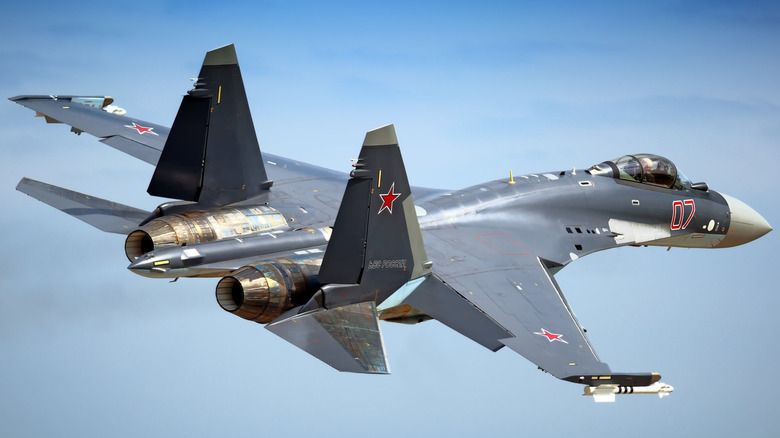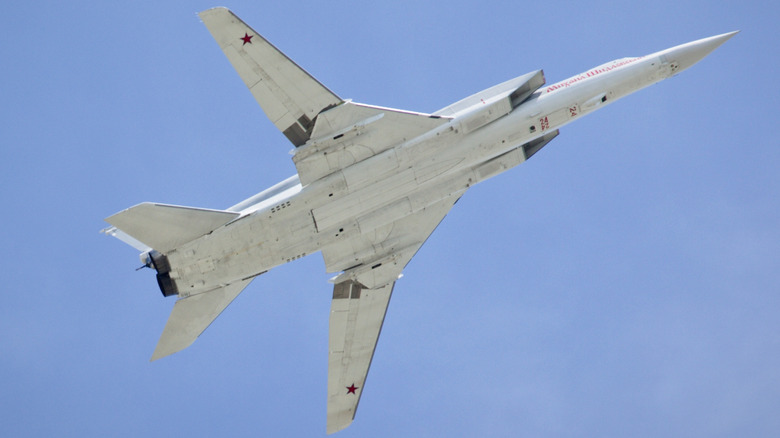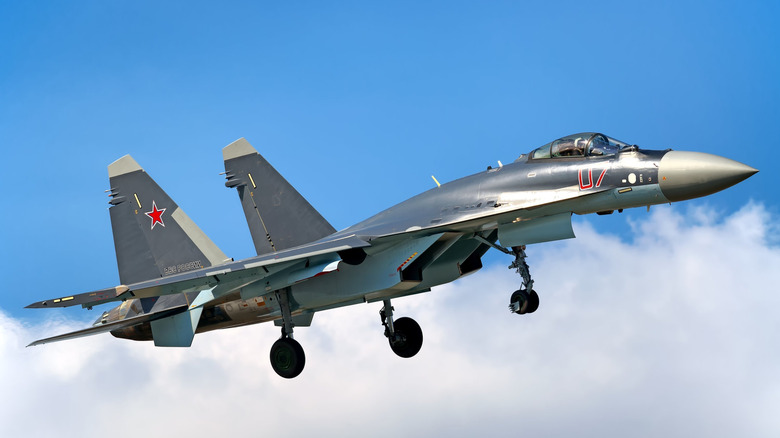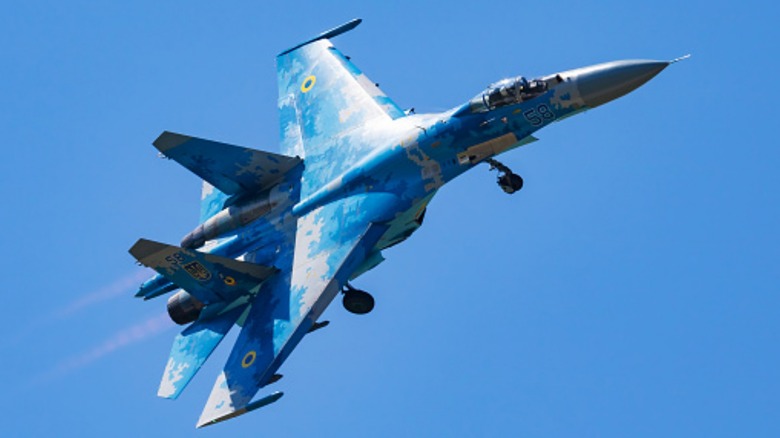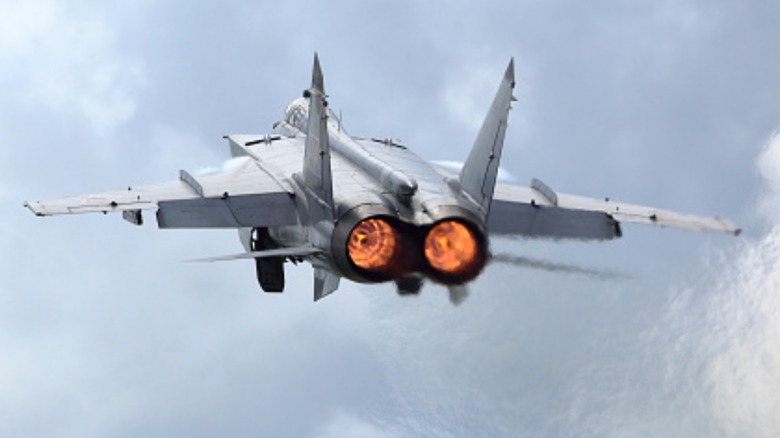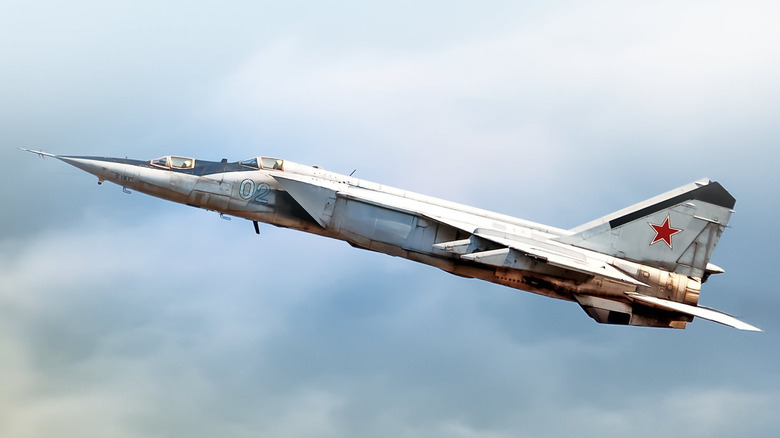The 5 Fastest Russian And Soviet Jets, Ranked By Top Speed
It probably won't come as much of a surprise to learn that speed is one of the key factors in designing fighter, attack, and interceptor aircraft. These military machines are used to fly out and attack inbound targets, maintain air superiority, and much more, with speed being one of the main capabilities that makes this possible. Since the first jet engine was strapped onto a German plane during World War II, militaries have been pushing the envelope in jet propulsion, and the Soviet Union and subsequent Russian Federation are no slouches in this department.
Russia has been developing speedy aircraft for much of the 20th and 21st centuries, with many of its fastest developed during the Soviet era. However, some of the newer models are exceedingly fast for modern aircraft. Granted, Soviet military vehicles weren't constructed with the same levels of safety as their Western counterparts.
Despite that, it's difficult not to marvel at the brilliant engineering that propels them through the sky faster than the speed of sound. Some of Russia's fastest aircraft aren't fighters; they're bombers, so there's a lot of variety where speed and Russian engineering coincide. Of the many jets the Russians and Soviets built since they first began manufacturing aircraft in the early 1900s, these five are the fastest to see widespread military service in and out of Russia.
Tu-160 White Swan (Mach 2.05)
When most people think of the fastest Russian or Soviet jets, they probably imagine fighters. After all, they're required to move quickly to perform their missions, but that didn't stop Soviet engineers from creating an incredibly fast bomber. The Tu-160 "White Swan" is a Soviet-era heavy bomber that remains one of two Russian strategic jet bombers in service today. The Tu-160 is a massive and deadly aircraft capable of carrying 12 cruise missiles, including a nuclear-tipped one, as well as several types of long-range missiles and gravity bombs.
The Tu-160M2, the latest version that debuted in 2021, is powered by four Kuznetsov NK-32 afterburning turbofan engines. These engines provide an exceptional amount of thrust. The bomber can zip through the skies at Mach 2.05 (1,560 mph), making it the fastest and heaviest aircraft capable of reaching that speed. It's a beast of a plane, too, as the Tu-160 can carry a whopping 99,208 pounds of ordnance.
In terms of range, the Tu-160 can theoretically fly 11,785 miles, but typically ranges up to 7,643 miles under normal conditions. The Soviets designed the bomber in response to the United States' development of the B-1 Lancer, and the Tu-160 is much faster than its American counterpart. The Lancer's top speed is Mach 1.2 (921 mph), giving the Russian bird the advantage. Not only has the Soviet bomber been renowned for its speed, raking in 44 world records, its size and endurance are equally remarkable.
Su-35 Super Flanker (Mach 2.25)
The Sukhoi Su-35 "Super Flanker" is a twin-engine air superiority fighter that was first developed by the Soviet Union. The aircraft continues to serve in the Russian Air Force and is an export model sold to nations like the People's Republic of China and Algeria. It's is a mid-generation aircraft, often referred to as generation 4++, and it's quite capable. The Su-35 has undergone modernization efforts and is comparable to the F-16 Fighting Falcon, which falls short of the same mid-generation standing due to a lack of stealth.
The Su-35 is supermaneuverable, and its radar can pick up airborne targets up to 217 miles away. The fighter is powered by two Saturn/UFA AL-31F 117S turbofan engines, each of which has a thrust-vectoring nozzle. They provide an unrefueled range of 982 miles, though the Su-35 can be refueled midflight, allowing for unlimited range. In terms of speed, the Su-35 can reach Mach 2.25 (1,726 mph). Needless to say, that's incredibly fast, and while the Su-35 features many modern upgrades that make it comparable to something like the F-16, it isn't as up-to-speed as other Russian fighters.
Still, the Su-35 is impressive and can carry a wide variety of weapon systems and munitions. These include air-to-air missiles, air-to-ground missiles, cruise missiles, guided and unguided bombs, anti-radiation missiles, tactical missiles, anti-ship missiles, and much more. It also carries a variety of rockets, electronic warfare countermeasures, a jamming system, chaff and flare dispensers, and a 30 mm machine gun should anyone get too close.
Su-27 Flanker (Mach 2.35)
The Soviet Union developed the Su-27 "Flanker" in response to the United States' introduction of the F-15 Eagle. Like that fourth-generation American aircraft, the Su-27 continues to operate and has undergone a great deal of modernization upgrades since its introduction in the early 1980s. The Su-27 was the peak of Soviet aeronautical design, and it's a highly capable fourth-generation fighter. The Su-27 boasts a range of 2,423 miles and is powered by two Saturn/Lyulka AL-31F afterburning turbofan engines, delivering a combined thrust of 55,114 lbs.
The Su-27 can reach speeds of Mach 2.35 (1,803 mph), and it has a service ceiling of 59,055 feet. The model was so favored by the Soviets and subsequent Russian Federation that it was modified into multiple variants. Indeed, the Su-31 and Su-35 are both variant models of the Su-27. Depending on the mission it was needed for, the Su-27 could fly in support of ground-based or naval-based operations anywhere that Russia could extend its forces.
For its armament, the Su-27 sports a single 30 mm machine gun and eight external hardpoints. It also has two wingtip rails. It can be armed with a variety of air-to-air missiles and bombs, including cluster bombs. It also carries rocket pods and an electronic countermeasure pod. Russia continues to operate Su-27s but began phasing them out for more modern aircraft. These days, nations like China and even Ukraine operate fleets of Su-27s.
MiG-31 Foxhound (Mach 2.83)
The Mikoyan MiG-31 "Foxhound" is another fighter developed for the Soviet Air Forces, dating back to the 1970s. It is one of the fastest operational combat aircraft ever manufactured, and despite being over 45 years old, the Russian Aerospace Forces continue to fly them. Granted, the modern MiG-31 is upgraded over its 20th-century predecessor, but the primary aircraft remains. Russia has used the MiG-31 in Ukraine during its invasion of that country, and it has proven its worth against Ukrainian air defenses and Ukrainian fighters.
The MiG-31 is powered by two D30-F6 jet engines capable of pushing the aircraft to Mach 3.2 (2,455 mph). This was technically its maximum speed, but it never flew that fast during normal operations because the airframe wasn't built to sustain the engines' maximum limits. As a result, the actual operational speed of the MiG-31 was typically limited to Mach 2.83 (2,171 mph), which is still decidedly fast.
Speed is especially important for the MiG-31, as it's used primarily as an interceptor capable of reaching launched cruise missiles quickly. In this role, the MiG-31 can be used to stop such missiles from hitting their targets, and they can engage other fighters, UAVs, and helicopters. They're also used as bomber escorts and to counter strategic bombers through air dominance. For armament, the MiG-31 carries air-to-air missiles, a 30 mm cannon, long-range missiles, air-to-ground missiles, and a variety of laser-guided bombs.
MiG 25-Foxbat
The Mikoyan MiG-25 "Foxbat" was a terrifying jet when it was introduced in 1970, as it was cutting edge in all kinds of ways. To say that the MiG-25 was fast would be an understatement, as it is the fastest combat jet ever produced. It was capable of reaching such speed that it could potentially intercept the U.S.' SR-71 Black Bird spy plane. In fact, it's the second fastest serially produced or operational aircraft behind the SR-71, which had a maximum speed of Mach 2.86 (2,193 mph).
The MiG-25 had the same speed capabilities as its successor, the MiG-31, so it could reach Mach 3.2. This was accomplished via the aircraft's two Tumansky R-15B-300 turbojet engines capable of producing a combined 45,000 lbs. of thrust with afterburners. These enabled a baseline speed of Mach 2.83, so while it could technically exceed that speed, it didn't do so under normal operating conditions, as damage to the engines could result from pushing them too far.
Another thing going for the MiG-25 was its operational ceiling of 67,000 feet, which put it out of range of many potential adversarial aircraft. It consumed fuel like crazy, so it had a relatively limited combat radius of only 186 miles at max speed. It also had limited maneuverability due to its large size and weight, which is why it functioned far better as an interceptor than a dogfighter. Russia no longer operates the MiG-25, leaving Libya and Syria as its only operators today, according to Flight Global .
